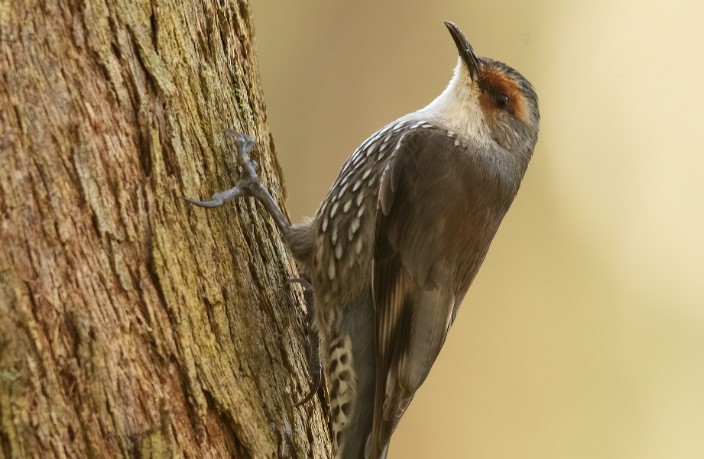The cool, tall Eucalypt forests along the Great Dividing Range and southeast coast are the core habitat of the Red-browed Treecreeper (Climacteris erythrops). It belongs to the family Climacteridae. It is also known as the Red-Eyed Treecreeper, or ‘Woodpecker’.
It enters dry forests locally as well as subalpine snow gum woodland. However, it avoids rainforests unless there are overhanging eucalypts to feed on. Throughout its range, the red-browed treecreeper occurs side-by-side with the white-throated red-browed treecreeper, foraging at different sites and avoiding the majority of competition for food—mainly ant-eaters.
The species often works on fallen logs and leaves smooth-barked eucalypts alone, spending much time rummaging through accumulated debris hanging from forks. The birds prefer the smoother outer branches of rough-barked eucalypts, despite the bark peeling.

In comparison to white-throated treecreepers, red-browed treecreepers have larger permanent territories that can be three times as large as those of white-throated treecreepers. Young males are tolerated by the dominant breeding pair for up to three years, but females usually leave within the first year. The size of the red-browed treecreeper is about 150–160 mm in length.
Read More: Rufous Treecreeper – The Tiny Charming Bird
The male bird’s upper parts are dark brown. The crown and nape are blackish; the rump is mid-grey. Wings are with pale buff bands across flight feathers. The tail is mid-grey with a broad black sub-terminal band on all but the central feathers. The upper face and eyebrows are rust-red. Throat dull white; upper breast plain brownish-grey; lower breast to belly boldly striped black-and-white; undertail buff-white with broken black crossbars. Their eyes are brown. The bill is dusky. Feet are dark olive-grey. There are two stripes on the upper breast of the female: rufous and dull white. The immature bird has a gray face, and its underparts are gray-buff with sporadic white streaks.
Red-browed Treecreeper’s call is rapid, sibilant chatter descending in pitch. It is often immediately followed by a sharp, descending two- or three-syllable trill from another bird. There are times when a call is harsh. Juveniles give high-pitched, strident notes, often monotonously. The Red-browed Treecreeper song consists of a shrill, upward-inflected note, quickly repeated up to four times.
Nesting and breeding occur in August and January. Nest building is started by the female, and then other members help to line the nest and feed the incubating female and her young in the nest. Foraging in the same tree or antiphonally calling each other keeps the pair in contact. At night, they roost mainly in hollows in dead tree branches. Nest a cup of bark, covered with a layer of fur, placed in a tree hollow, particularly a hollow dead branch of a eucalypt, 2–30 meters above ground.
Red-browed The treecreeper lays two delicate eggs, which are pale pink with close red-brown and dull purple blotching all over, especially at the larger end. The eggs are oval, at a size of about 22 x 17 mm. The incubation period is about 18–19 days for females. Young fledge in 25–26 days and sometimes double-brooded.
Red-browed treecreeper is found in cool eucalypt forests on ranges and coasts around the southeastern mainland, north to near Gympie, Queensland, and southwest to Daylesford, Victoria. There is no race.
Read More: Black-tailed Treecreeper (Climacteris melanura)







